Jim Berry
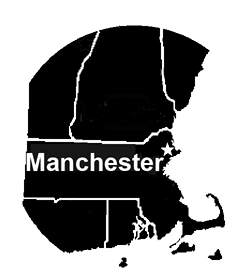 The 3400-acre Manchester-Essex Woods is located in those two towns at the base of Cape Ann in Essex County, Massachusetts. It is a mosaic of parcels of mixed ownership. The Manchester Essex Conservation Trust (the Trust) owns a third of the land, about 1100 acres. Other parcels are protected by the two towns, by the Essex County Greenbelt Association, and by The Trustees of Reservations. The remaining parcels are held privately, but almost all are "landlocked," with no access for development.
The 3400-acre Manchester-Essex Woods is located in those two towns at the base of Cape Ann in Essex County, Massachusetts. It is a mosaic of parcels of mixed ownership. The Manchester Essex Conservation Trust (the Trust) owns a third of the land, about 1100 acres. Other parcels are protected by the two towns, by the Essex County Greenbelt Association, and by The Trustees of Reservations. The remaining parcels are held privately, but almost all are "landlocked," with no access for development.
The Trust's goal is to continue researching the sometimes incredibly complicated ownership history of the many parcels and to work with the landowners to protect as many as possible, so that development can never fragment this beautiful woodland. For example, the Trust recently completed the purchase of 23 parcels containing 67 acres of woodland in Essex. That is an average of only three acres per parcel, which gives an idea of how many parcels remain to be protected.
For much more information on the Manchester-Essex Woods, including its history, view the 26-page "Woodland Guide," which you can access under the "Trail Maps" header on the home page of the Trust's website (www.mect.org). It will tell you, among other things, how the trails and other landmarks got their often unusual names.
The trail map reproduced here lays out the many trails by name and is crucial to getting around. The trails are well marked for the most part but can be confusing because of the many twists and turns. There are many parking areas, designated with a "P," but some are better known and thus more popular than others. My objective is not to provide detailed routes, but rather to allow the reader to choose a parking spot and take a combination of the trails in that section of the Woods. I will discuss only the more well-known and easily accessible trailheads at the end of this article.
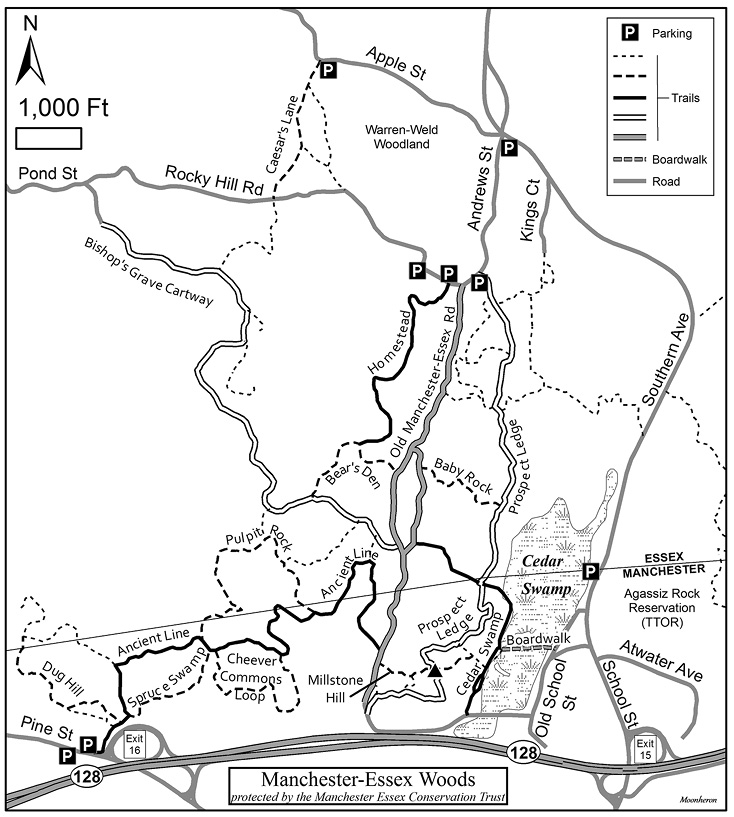
The Birds
But first, here is a summary of the birdlife of the Manchester-Essex Woods, with a concentration almost solely on the breeding season. The habitat here is deep forest with a lot of ledge. Much of it is swampy, so of course the mosquitoes are welcoming. The spring and summer climate here, like that of Cape Ann in general, is moister and cooler than it is in the interior parts of Essex County, due primarily to the cooling influence of the easterly winds off the ocean. This means that the plants tend to be more northern, including eastern hemlock, yellow birch, striped maple, hobblebush, and other species more commonly found in the White Mountains of New Hampshire. The climate and vegetation are reflected in the mix of birds, with somewhat greater proportions of the more boreal species than elsewhere in the county, and correspondingly fewer of the more southern species. But there are exceptions, as noted below.
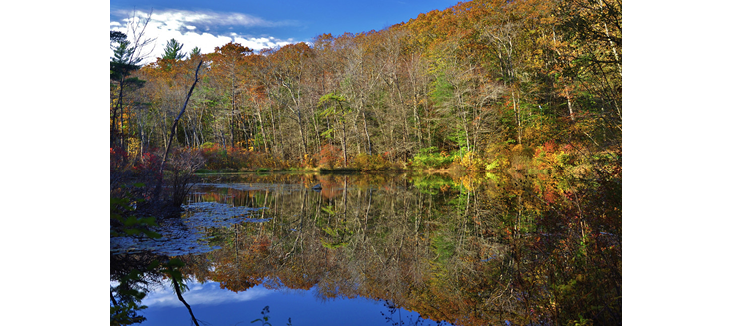
Heron Pond, mid-year. All photographs by Mike Dyer.
I reviewed all the birds I have entered in eBird for this property over the years from 1994 to the present, with possibly a few trips before that year that I have yet to enter. During this 24-year period, I have made 66 trips into the Woods and provided 56% of the complete checklists so far entered in eBird, all but three in the months of April through August. Since the Woods are essentially devoid of birds in the cold-weather months, the 63 lists from spring and summer form the basis of my remarks.
The vast majority of the water birds that I have seen were in the Cedar Swamp—also known as Heron Pond, though the pond is only one part of the Cedar Swamp—at the southeast corner of the property. This area, off School Street in Manchester, is the most well-known and heavily birded part of the Manchester-Essex Woods. The water birds I have found with any degree of regularity are Canada Goose, Wood Duck, Mallard, Double-crested Cormorant, Great Egret, Little Blue Heron, Green Heron, Black-crowned Night Heron, Glossy Ibis, Virginia Rail, and Herring Gull. I have seen about the same number of additional water bird species once or twice each. But the overall attraction of the site is the variety of breeding land birds, of which I will discuss the most interesting in taxonomic order.
The Woods used to be good for Ruffed Grouse, which I have recorded here three times. The last was a bird I flushed on the Bishop's Grave Cartway in April 2005. That decade was the last for this species in Essex County, though I suspect a few have been heard here and there since 2010. But on the whole, the Ruffed Grouse is essentially a bird of the past in much of eastern Massachusetts.
Among the raptors, Turkey Vultures are regular, and with so much ledge are no doubt regular breeders, as they favor rocky crevices and small caves for nesting sites. Jim MacDougall and I came close to finding a nest in spring 2002 when a pair hung around a small wooded cliff along a steep section of the Ancient Line Trail, but the birds refused to go to any putative nest site while we were present. It takes diligence to find their nests, but I still hope to find one in the Woods someday.
Northern Goshawks nested near the Bear's Den on the Homestead Trail in 1999. A botanist named Betty Wright found the nest and told me about it, but when I went to see it, the hawks came out to meet me and asked me to leave the area in no uncertain terms. I returned that fall and located the nest easily enough, but it went unused for several years before falling apart. I have not seen a goshawk in the Manchester-Essex Woods since 2001, though I heard a recent report of one elsewhere on the property. This forest is definitely suitable for nesting goshawks.
Both cuckoo species are regular in the Woods, but more so when there is an outbreak of gypsy moth caterpillars. One such year was 2000, when I saw three Yellow-billed Cuckoos on June 23. In my subsequent eBird entry I wrote: "Cuckoos were common this year due to a gypsy moth outbreak. The trees were raining frass." (Imagine—a special word just for a type of insect excrement!) Cuckoos have many habitats, and this deep forest is one of them. I have found black-bills more often than yellow-bills, seven times to four.
Of the woodpeckers, all five of the species that regularly breed in Essex County also nest in the Woods. (There are no records of Yellow-bellied Sapsuckers nesting anywhere in the county.) But one species is not as common here as it is in the rest of the county: the Red-bellied Woodpecker. I was amazed to discover that I have found them on only six of my 66 visits, versus 37–40 times for Downies, Hairys, and Northern Flickers. Elsewhere in the county, I am convinced that Red-bellies are the second-commonest woodpecker after the Downy. This relative scarcity of Red-bellies is the most notable thing about woodpeckers in the Manchester-Essex Woods. Pileateds are uncommon also, but they have large territories and are uncommon everywhere.
In the flycatcher department, Eastern Wood Pewees, Eastern Phoebes, Eastern Kingbirds, and Great Crested Flycatchers are all regular nesters, with the latter being the most numerous in my counts. One species that does not nest here—or anywhere else in Essex County—is the Olive-sided Flycatcher. (There is an old nest record from 1858 in Lynn, and the species may have nested into the early 20th century, per Townsend in his Supplement to the Birds of Essex County, 1920). They are rare in this forest, where I have encountered them only twice, both times in the Cedar Swamp. One of these birds sang for three solid hours from some of the many snags in that swamp on the incredibly late date of June 23, 2000. I was excited to think that he may have been a breeder. But he was probably doing all that singing because he had not been able to secure a mate. Sure enough, the next day he was gone.
Of the vireos, I have seen four species here: Red-eyed (30 visits), Warbling (14 visits), Blue-headed (7 visits), and Yellow-throated (1 visit). The Warbling Vireos are the easiest to watch and to see at nests, as they build along the dirt road—Old School Street—that leads into the property at the Cedar Swamp and also along the boardwalk that crosses the swamp from that road. The other species are scattered throughout the Woods, most of which is good habitat for Blue-headed Vireos.
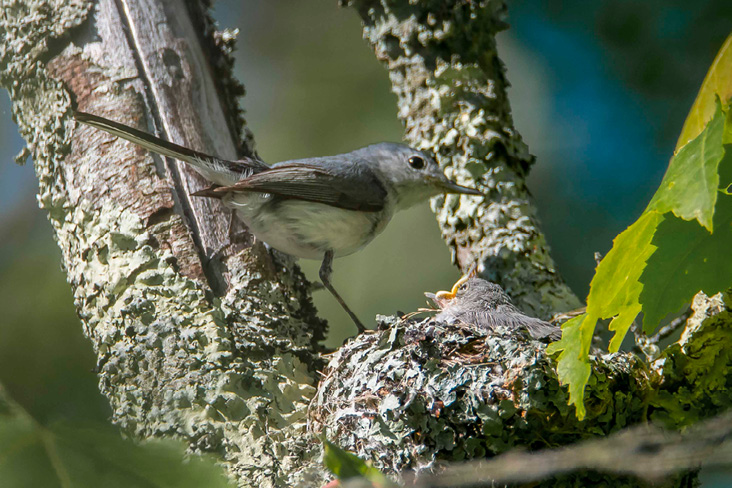
Blue-gray Gnatcatcher
The Common Raven is a boreal species that was first found nesting in Essex County in 2004 by Rick Heil, across School Street from the Cedar Swamp in a quarry near the Manchester Athletic Club. Ravens are often seen and heard flying over the Cedar Swamp area, though no one to my knowledge has discovered any more nests in the vicinity.
Among the parids and sittids, Black-capped Chickadees, Tufted Titmice, and White-breasted Nuthatches are all common—seen on 57, 55, and 40 of my visits, respectively, with maximum numbers of 51, 30, and 15, respectively. But on only four occasions have I seen Red-breasted Nuthatches, which I should think would thrive in such boreal-flavored habitat. This low number of observations challenges my theory that the habitat favors the more northerly species. Maybe 66 visits are not enough to get a proper sense of these irruptive birds! At any rate, I have no evidence that Red-breasted Nuthatches nest here.
Blue-gray Gnatcatchers nest annually along Old School Street and the boardwalk at the Cedar Swamp, along with the Warbling Vireos. Their nests are, if anything, easier to see than those of the vireos, as they nest a bit lower in bare crotches of saplings or saddle their nests along angled branches, building one side higher to compensate for the angle. They are not that shy of humans and are a treat to watch—most of the time. Several of us monitored one nest in 2004 until fledging on or about June 9, but a day or two later Phil Brown saw one fledgling floating dead in the water and another get caught and eaten by a frog! Life is tough for baby gnatcatchers.
Of the spotted thrushes, Veeries (seen on 39 visits), Hermit Thrushes (35 visits), and Wood Thrushes (33 visits) are all regular breeders. Veeries are the most numerous, judging by my many counts in double digits, with a high of 26 on June 25, 2009. Hermit Thrushes are the least common, but they are the least common breeders of the three in Essex County generally. The Manchester-Essex Woods, however, is where I had one of my largest breeding-season counts of Hermit Thrushes, nine birds on June 27, 2003. Most of the Hermits I have found here have been clustered along the Ancient Line and Spruce Swamp trails in the southwestern section off Pine Street, and I remember confirming them breeding on the Millstone Hill Trail farther east.
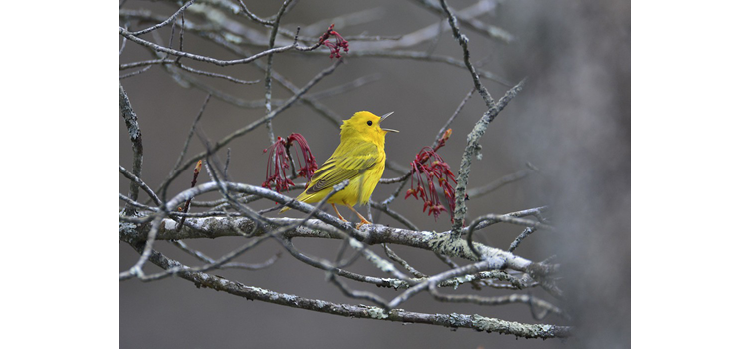
Yellow Warbler.
Breeding warblers include Ovenbird (seen on 42 visits with a high count of 48 birds), Northern Waterthrush (19 visits, high of 6), Black-and-white Warbler (39 visits, high of 10), Common Yellowthroat (34 visits, high of 17), Yellow Warbler (19 visits, high of 8, all in the Cedar Swamp), Pine Warbler (43 visits, high of 8), and Black-throated Green Warbler (35 visits, high of 13). The most memorable nesting event I have had here was finding a Black-and-white Warbler nest on June 28, 2005. I found it by sitting patiently for an hour and watching both adults carrying food to determine exactly where they went. This nest was off the Ancient Line Trail near the Cheever Commons Loop. The nest, containing three young warblers with their eyes open, was tucked into dead leaves on a steep hillside so that the entrance was on the side. The young faced the opening, looking downhill. I did not return to disturb these birds any more. This nest is one of my most cherished birding memories.
Possibly breeding warblers include Louisiana Waterthrush, Nashville Warbler, and Canada Warbler. On May 6, 2002, I heard two singing Louisiana Waterthrushes in the southwest corner of the property off Pine Street, one of them from the swamp along the road and the other across the swamp from the Dug Hill Trail. I have not heard them in the Woods since. I have encountered Nashville Warblers four times in June here and another time on May 29. Nashvilles are rare breeders in Essex County, and these breeding-season birds were found on scrub-oak hilltops where breeding conditions seemed right for them. The hilltops were, as I recall, on the Prospect Ledge and Baby Rock trails, but I never found any direct nesting evidence. Similarly, I found Canada Warblers along the Spruce Swamp Trail—off the Ancient Line Trail—five times in June and July. The closest I came to confirming breeding was on June 27, 2003, when I heard two singing males and saw one of them plus a female. But I didn't see either bird carry anything. Canadas are another rare breeder in the county, or possibly an ex-breeder.
Of the remaining species, Eastern Towhees (seen on 37 visits), Scarlet Tanagers (35 visits), Northern Cardinals (37 visits), Baltimore Orioles (40 visits), and American Goldfinches (52 visits) are more common here than Rose-breasted Grosbeaks (11 visits), Indigo Buntings (8 visits), and Purple Finches (9 visits, of which 5 were in June and July). Indigo Buntings are concentrated around a large, mixed grass and shrubby clearing along Rocky Hill Road in the north end of the Woods, where I have found two nests.
The Trails
By now the reader will have become familiar with many of the trails I have named above. To access the Manchester-Essex Woods and its extensive trail network, I recommend any of the following trailheads.
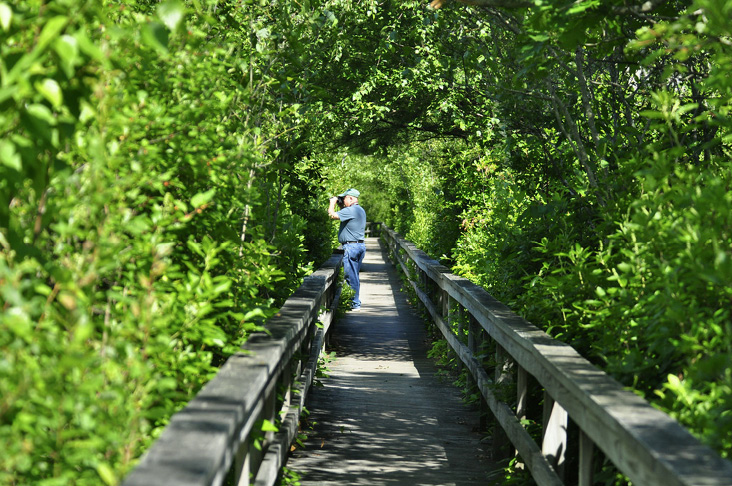
Author on boardwalk.
The most frequently accessed trailhead is at the main parking area for the Woods at its southeast corner on School Street in Manchester. This lot is just beyond the Essex town line (unmarked) as one drives south on Southern Avenue from Essex. (This renaming of the road follows the quaint Massachusetts tradition that every road must change names at every town line.) Most field trips meet at this parking area. It is the "P" across the road from the adjacent 101-acre Agassiz Rock Reservation, a Trustees of Reservations holding that is also worth exploring. The lot is obvious and is only a quarter-mile north of exit 15 for School Street off Route 128, making easy access for readers arriving from the south and west of Essex and Manchester.
From this trailhead you must cross the Cedar Swamp on the boardwalk to reach other trails, meaning you will see all the water birds, Warbling Vireos, gnatcatchers, and orioles during your first half-hour. After you cross the swamp you have your choice of the Cedar Swamp Trail, the Prospect Ledge Trail, or the Millstone Hill Trail. If you bear left after leaving the boardwalk and take the first right up the hill and then the first left to continue up the steep hill, you will soon reach the summit of Millstone Hill, offering good views and shrubby hilltop habitat to listen for Nashville Warblers.
You can enter the southwest corner of the Woods from Pine Street in Manchester, just off Route 128 at exit 16. When coming from the west, turn right at the exit to go north on Pine Street, drive under the highway, and park immediately in one of two dirt pulloffs on your left. The trail, on the swamp (right) side, is marked and follows the inside of a barrier fence before turning left into the Woods. From this trail you can choose any of the Dug Hill, Ancient Line, Spruce Swamp, or Pulpit Rock trails, or the Cheever Commons Loop.
The northeast section is accessible from Andrews Street, which starts at the intersection of Southern Avenue and Apple Street in Essex. Drive south on Andrews and park at any of the three "Ps" along Andrews Street or the east end of Rocky Hill Road, which is gated at the westernmost parking spot. From here you can walk the Prospect Ledge Trail from its north end, the Old Manchester-Essex Road—the main trail through the entire Woods—or the Homestead Trail, plus any of the side trails off these, such as the Bear's Den and Baby Rock trails. If you need an Indigo Bunting fix, walk past the gate up Rocky Hill Road until you come to the large complex of clearings on your right. It isn't far.
The north-central entrance to the Woods is on Apple Street, roughly a half-mile west of its intersection with Southern Avenue. From here you enter the Warren-Weld Woodland, which is in essence part of the Manchester-Essex Woods. The trail is called Caesar's Lane. Bear left at the split if you want to get to the aforesaid clearings, or right if you want to continue to the Bishop's Grave Cartway. This trail is the longest in the Woods; it eventually links up to the trails farther south.
Needless to say, carry the map with you, for it will help you keep track of where you are going in this Mirkwood-like forest.
A final word: eBird really helped me write this site guide. Being able to look at my life list of species for the hotspot—mercifully, it is all one hotspot—and seeing how often I had seen or heard each species, with dates and numbers, helped me organize the writing and connect birds with specific trails. It saved me a lot of time, and I recommend it to others writing site guides for their local patches.
Jim Berry is finally putting the finishing touches to his book on the birds of Essex County. He assures readers that it will be published in this lifetime (with luck, in the next couple years). He would also like to thank Mike Dyer and Frances Caudill for helpful comments on the draft, and Mike for the photos used in the article.